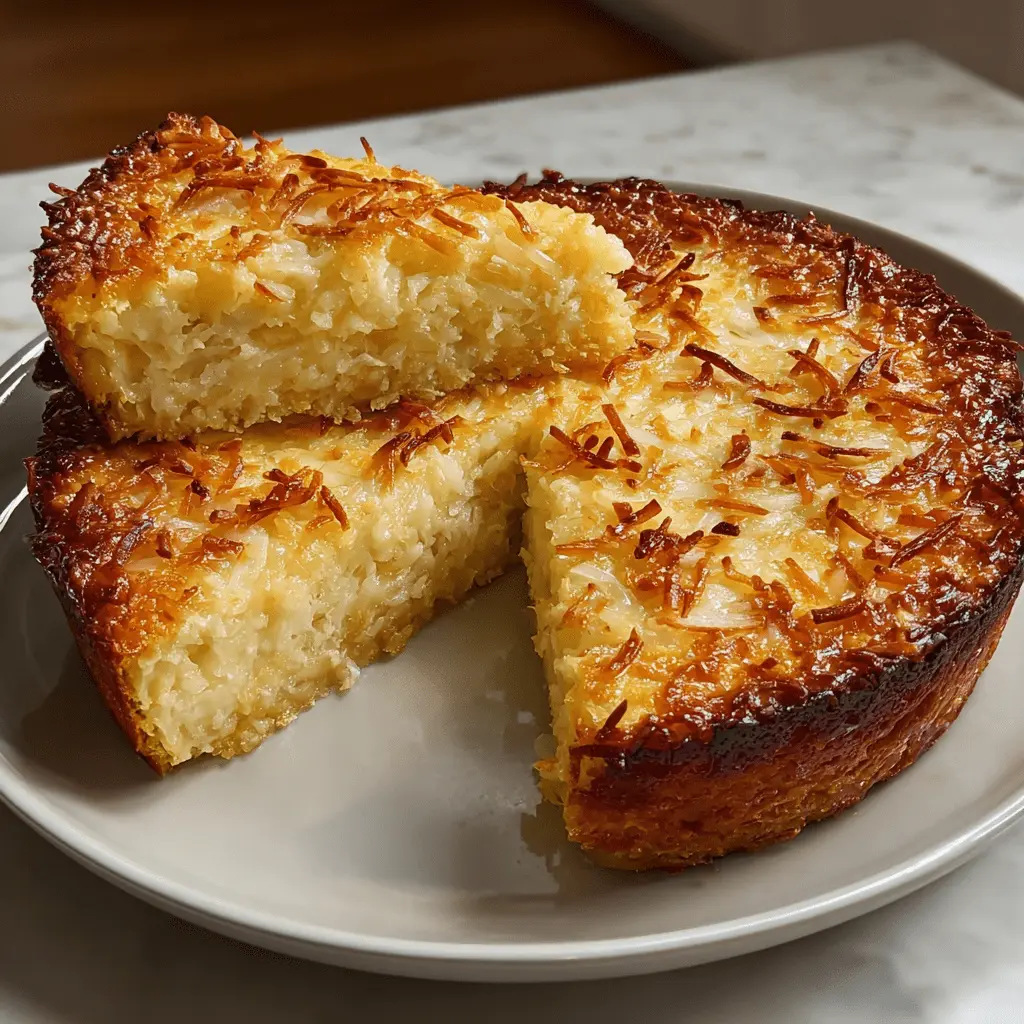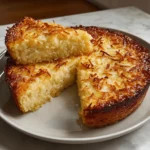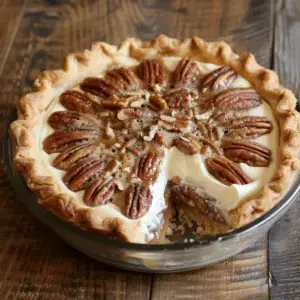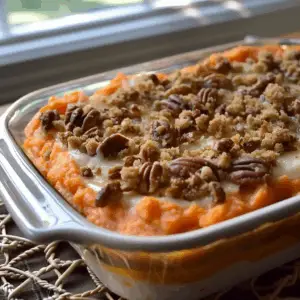If you’re looking for a no-fuss, old-fashioned dessert that feels like a tropical escape in every bite, look no further than crustless coconut pie. Also known as impossible coconut pie, this nostalgic dessert magically forms its own crust while baking, creating a golden, coconut-kissed top and creamy custard center.
This easy coconut pie recipe has been a beloved staple in Southern kitchens for decades and is the perfect addition to any potluck, Sunday dinner, or weeknight treat. The best part? You don’t need a rolling pin, crust dough, or even a store-bought crust—this pie truly is impossible in the best way.
As you whisk the ingredients together, you might be reminded of other simple custards or flans, similar to custard, only with the tropical twist of coconut. And unlike many coconut desserts that call for condensed milk, this one is light and airy, thanks to regular milk and eggs.
For bakers unfamiliar with coconut desserts, you can learn more about coconut itself, its culinary uses, and its sweet, chewy shredded form that makes this dessert shine.
🍴 What is crustless coconut pie?
Crustless coconut pie is a simple, self-forming dessert that starts as a liquid batter and ends up with a crust-like bottom, a custardy center, and a golden, coconut-laced top. This pie is sometimes referred to as an “impossible pie” because the batter layers itself during baking, creating a perfect pie texture without a crust.
Made with pantry staples like flour, eggs, sugar, and milk, the pie is both cost-effective and impressive. The coconut floats during baking, forming a golden toasted layer, while the eggs and flour thicken into a soft, sliceable custard.
The pie is ideal for:
-
Casual family dinners
-
Holiday desserts
-
Brunch tables
-
Tropical-themed events
You’ll often find this dessert among other vintage-style recipes like those featured on Pinterest in collections such as crustless dessert ideas or easy pie recipes, proving its timeless appeal.
🌴 Origins of the recipe
The crustless coconut pie gained popularity in the mid-20th century during the era of boxed mixes and quick-fix desserts. It was famously printed on boxes of Bisquick in the 1970s as one of their “impossible pie” recipes. Though modern versions often skip Bisquick, the concept remains the same: mix, pour, and bake.
Southern cooks embraced this dessert for its ease and minimal cleanup. It became a staple at church gatherings, family reunions, and community potlucks, passed down through generations.
Interestingly, the technique mirrors older European custard pies, but with a uniquely American shortcut twist. The use of shredded coconut gave it a tropical flair, and its enduring popularity is due in part to the growing appeal of coconut desserts worldwide, like those in coconut desserts.
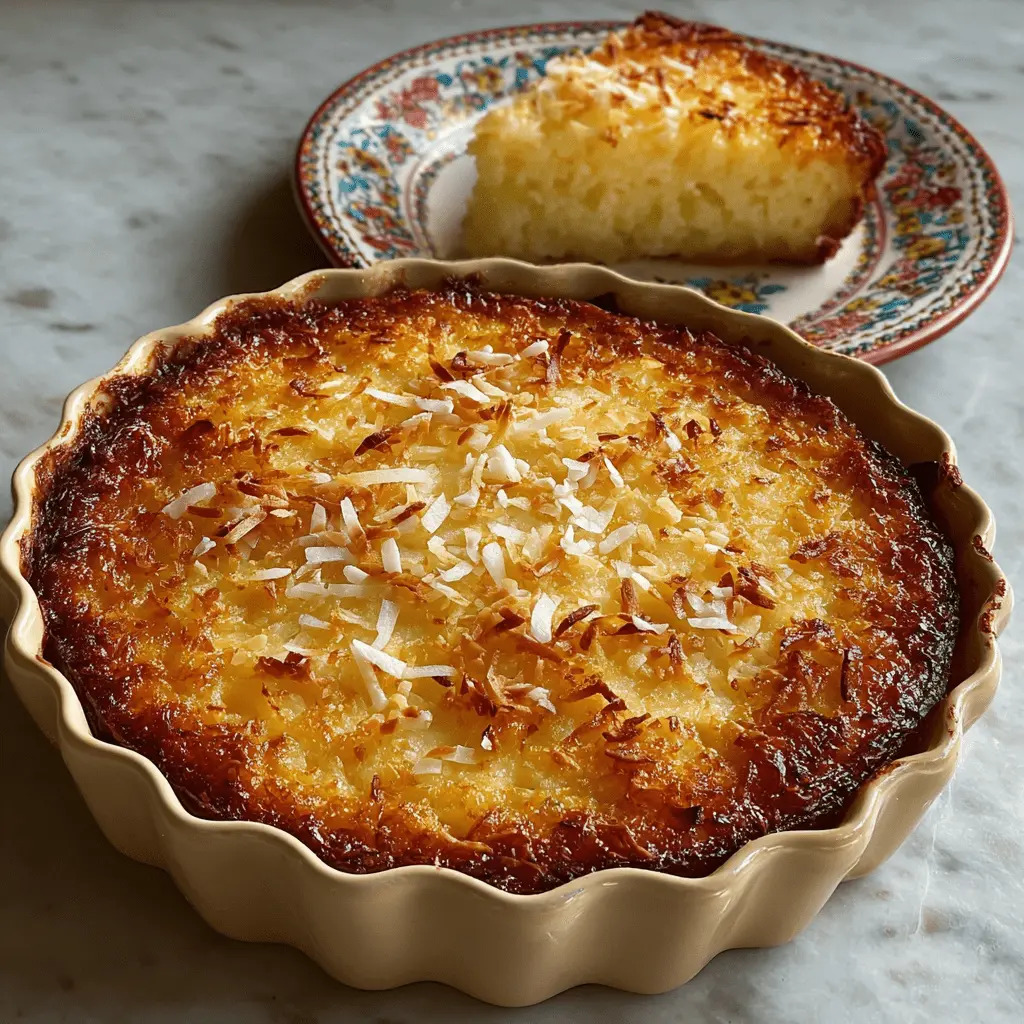
🥛 Ingredients overview
This recipe calls for straightforward ingredients that are easy to find in any grocery store. Each item plays a crucial role in the pie’s taste and structure:
-
All-purpose flour: Provides light structure; not too dense. Learn more about all-purpose flour.
-
Granulated sugar: Balances the coconut and provides that caramelized top.
-
Unsalted butter: Adds moisture and a rich base flavor.
-
Milk: Traditional dairy milk gives the custard its creamy consistency.
-
Eggs: Binds everything and sets the custard.
-
Vanilla extract: Enhances the natural sweetness and coconut flavor. Discover more about vanilla extract.
-
Sweetened shredded coconut: The star of the show—chewy, tropical, and toasty.
-
Salt: Just a pinch to balance out the sweetness.
These ingredients are typically already in your kitchen, making this a perfect spur-of-the-moment dessert. The only specialty item, coconut, is common in both baking and savory dishes. If you’re interested in expanding your coconut use, the Wikipedia page on coconut has useful context.
🥥 Ingredient substitutions and dietary options
Want to make this pie more accommodating? Here are several ways to adapt the recipe while preserving its delicious flavor:
For gluten-free diets:
-
Swap the all-purpose flour with a gluten-free blend.
-
Almond flour works, but may alter texture slightly.
For dairy-free needs:
-
Use unsweetened almond milk or coconut milk.
-
Replace butter with plant-based alternatives like vegan margarine.
For reduced sugar:
-
Use stevia blends or monk fruit sweeteners. Adjust quantity to maintain consistency.
For egg-free baking:
-
Substitute each egg with a flax egg (1 tbsp ground flax + 3 tbsp water).
-
Commercial egg replacers work well, but avoid reducing too many eggs, as they help form the custard.
Other variations:
-
Try using unsweetened shredded coconut and add extra sugar to compensate.
-
Add a splash of almond extract for a nuttier flavor.
For more variations like these, explore recipes featured in impossible pie inspiration.
💡 Tips for the best crustless coconut pie
To ensure a successful, bakery-style pie every time, follow these key tips:
-
Use room temperature eggs and milk: Helps everything blend smoothly.
-
Whisk, don’t overbeat: Overmixing can cause cracks in the custard.
-
Grease your pie dish well: Ensures easy removal and clean slices.
-
Use a glass or ceramic dish: Conducts heat evenly, promoting that golden top.
-
Let it cool completely: The pie finishes setting as it cools.
Texture is everything in a custard-based dessert, and improper mixing or oven temperature can impact the final result. As noted in culinary technique resources like baking techniques, correct heat distribution is key to creating the layered effect this pie is known for.
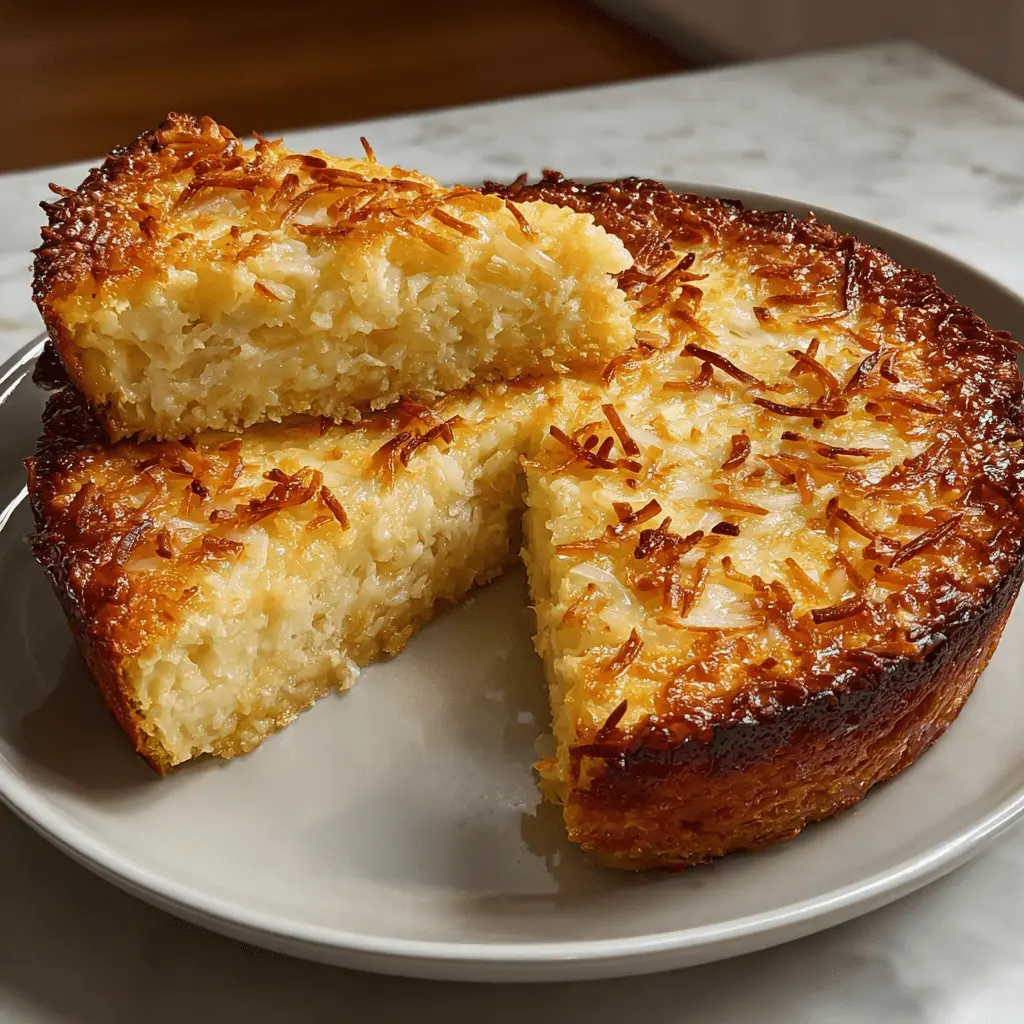
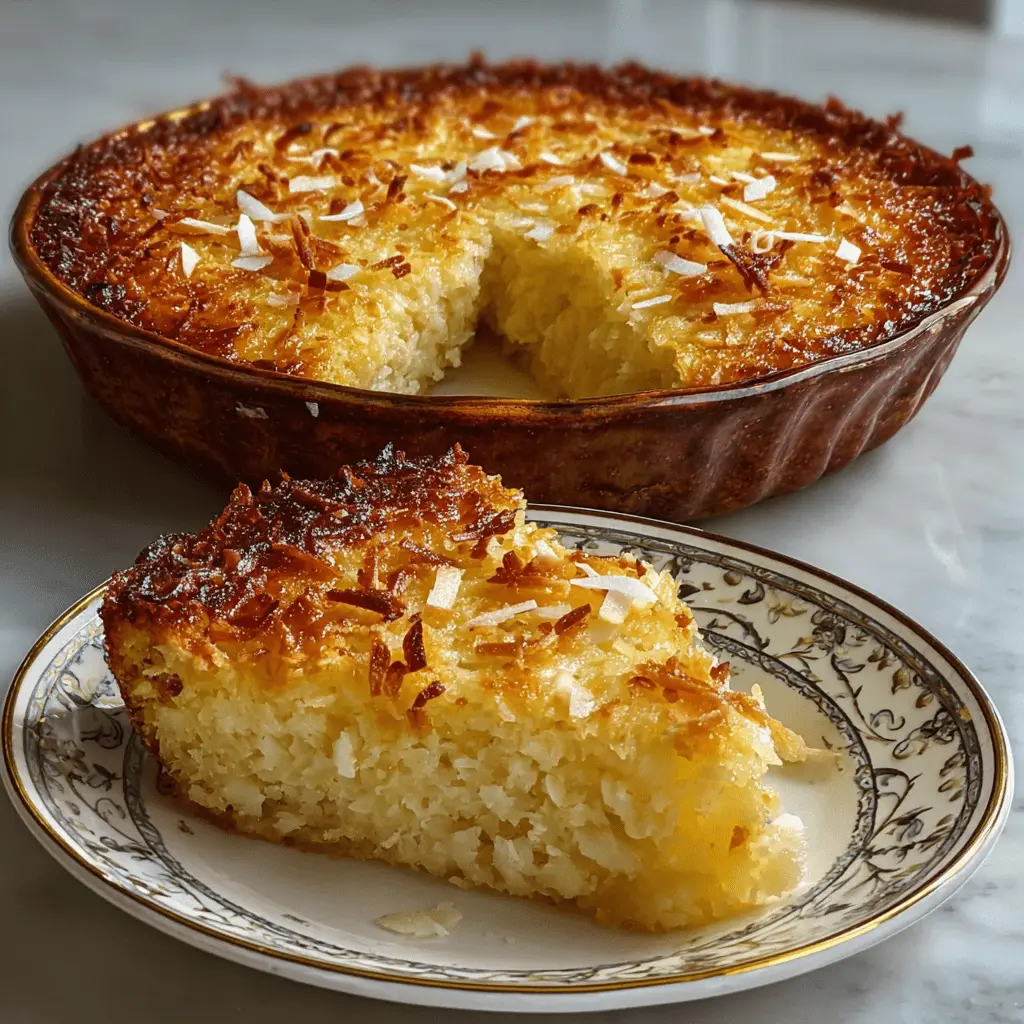
👩🍳 Step-by-step instructions
Here’s how to make the perfect crustless coconut pie from scratch.
Ingredients:
-
½ cup all-purpose flour
-
1½ cups granulated sugar
-
½ cup unsalted butter, melted
-
2 cups milk
-
4 large eggs
-
1 tsp vanilla extract
-
1½ cups sweetened shredded coconut
-
Pinch of salt
Instructions:
-
Preheat oven to 350°F (175°C). Grease a 9-inch pie dish with butter or nonstick spray.
-
In a large bowl, whisk together the flour, sugar, and salt.
-
Add melted butter, milk, eggs, and vanilla. Whisk until fully combined.
-
Stir in the shredded coconut.
-
Pour mixture into prepared pie dish.
-
Bake for 45–50 minutes, until top is golden and a knife inserted comes out clean.
-
Cool completely before slicing.
Pro tip: Don’t worry if it seems too liquid at first—the custard firms up as it cools.
😋 Texture and taste profile
When done right, crustless coconut pie offers a unique, triple-layered texture:
-
Golden, chewy top: Formed by shredded coconut and sugar.
-
Creamy middle: A smooth custard, light and eggy.
-
Slight crust: A denser layer forms from the flour settling during baking.
The taste is rich, sweet, and unmistakably coconut-forward, with undertones of vanilla and butter. It’s not overly heavy, making it perfect after a savory meal.
Unlike denser coconut pies, this version is soft and spoonable, almost like a hybrid between flan and pie.
🍓 Serving suggestions
Crustless coconut pie is incredibly versatile when it comes to presentation. Here are some delicious ways to serve it:
-
Room temperature: The classic method; slices hold their shape well.
-
Chilled: Refreshing in warmer weather, with a firmer texture.
-
Toppings:
-
Whipped cream
-
Toasted coconut flakes
-
Fresh berries (strawberries, blueberries)
-
-
Sides:
-
Hot coffee or tea
-
Sparkling water with lime
-
Feel free to customize depending on the occasion. For example, brunch events benefit from berry garnishes, while weeknight desserts might call for a simple whipped topping.
🧊 Make-ahead and storage tips
This dessert stores beautifully, making it ideal for prepping ahead.
Refrigeration:
-
Let the pie cool completely.
-
Cover with plastic wrap or store in an airtight container.
-
Lasts up to 4 days in the fridge.
Freezing:
-
Wrap tightly in two layers of plastic and foil.
-
Freeze for up to 2 months.
-
Thaw in the fridge overnight before serving.
Reheating:
-
Warm slices in the microwave for 10–15 seconds.
-
Best served chilled or room temperature to preserve texture.
🧁 Variations to try
Once you’ve mastered the basic recipe, try these exciting flavor twists:
-
Chocolate coconut pie: Stir in ½ cup mini chocolate chips before baking.
-
Tropical pineapple twist: Fold in ½ cup crushed pineapple (well-drained).
-
Lemon coconut pie: Add 1 tablespoon lemon zest to the batter.
-
Almond-coconut pie: Use almond extract instead of vanilla.
-
Mini coconut pies: Bake in muffin tins for bite-sized treats (adjust time to 20–25 mins).
Each variation brings a new layer of flavor, perfect for seasonal changes or different dietary needs.
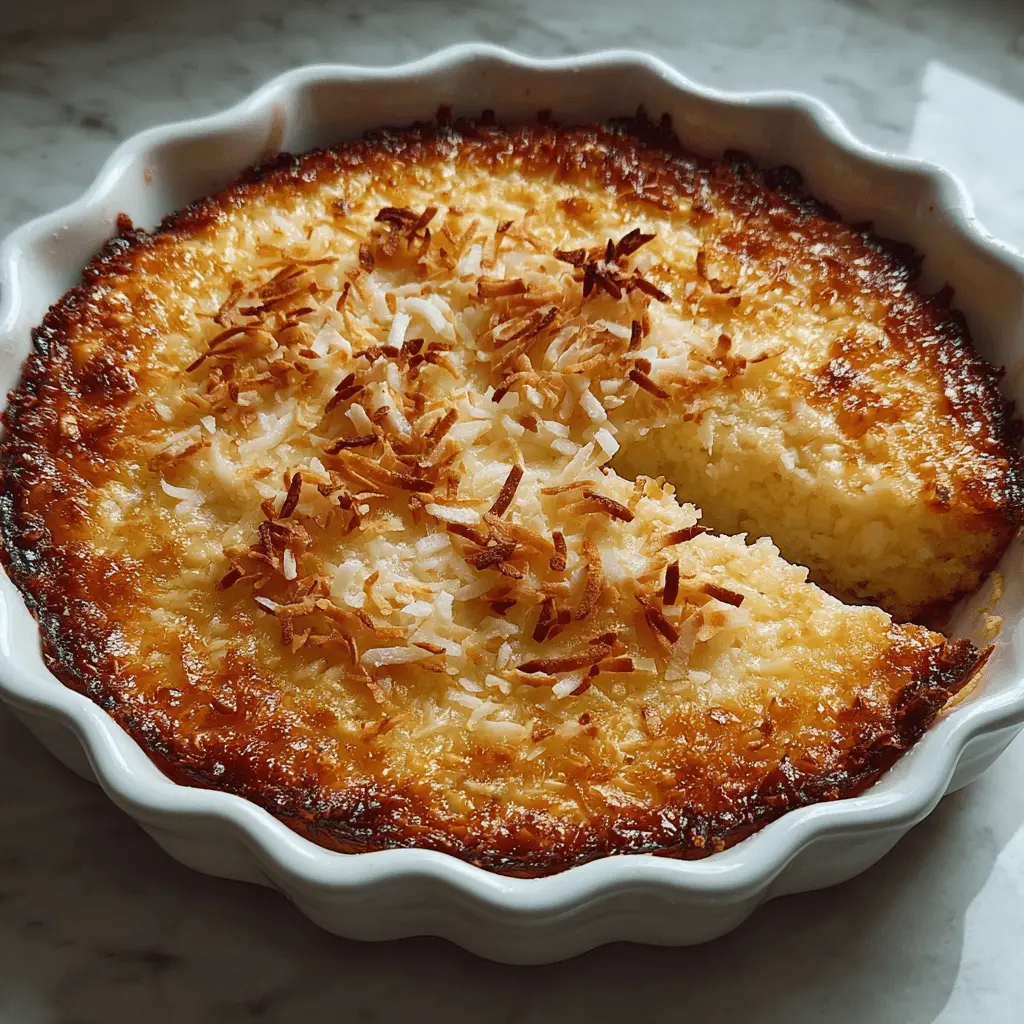
❓ FAQs – crustless coconut pie questions answered
Can I make coconut pie without flour?
Yes! You can use coconut flour or almond flour as alternatives, but expect texture differences.
What is an impossible pie?
An impossible pie is a custard-style dessert that forms its own crust during baking—no dough needed.
Can I use unsweetened coconut instead?
Yes, but you may need to add ¼ cup extra sugar to balance the flavor.
Why does the pie form layers on its own?
The flour settles, the eggs create custard, and the coconut rises, creating natural layers.
How do I know when it’s done baking?
Insert a knife into the center; it should come out clean. The top should be golden brown and slightly firm.
🧾 Nutrition information
Here’s the approximate nutrition breakdown per slice (based on 8 servings):
| Nutrient | Amount per slice |
|---|---|
| Calories | 340 |
| Fat | 18g |
| Saturated Fat | 12g |
| Carbohydrates | 40g |
| Sugar | 30g |
| Protein | 6g |
| Fiber | 2g |
| Sodium | 90mg |
Note: Values may vary depending on substitutions and serving size.
By following this guide, you can confidently prepare a crustless coconut pie that’s both timeless and customizable. Whether you’re a beginner baker or a seasoned dessert enthusiast, this pie is guaranteed to impress with its ease, flavor, and delightful texture.
And if you’re looking to explore more nostalgic dessert ideas, be sure to check out recipes across Pinterest’s easy pie boards and deepen your knowledge of ingredients through Wikipedia and other food references. Happy baking! 🥧
PrintCrustless Coconut Pie
A simple, old-fashioned crustless coconut pie that forms its own golden top and custardy center as it bakes. No crust, no rolling—just mix, pour, and bake! Perfect for brunch, potlucks, or a comforting weeknight dessert.
- Prep Time: 10 minutes
- Cook Time: 45–50 minutes
- Total Time: ~1 hour
- Yield: 8 slices
- Category: Dessert
- Method: Baked
- Cuisine: American (Southern-inspired)
Ingredients
-
½ cup all-purpose flour
-
1½ cups granulated sugar
-
½ cup (1 stick) unsalted butter, melted
-
2 cups milk (whole milk preferred)
-
4 large eggs
-
1 teaspoon vanilla extract
-
1½ cups sweetened shredded coconut
-
Pinch of salt
Instructions
-
Preheat oven to 350°F (175°C). Lightly grease a 9-inch pie dish with butter or nonstick spray.
-
In a large mixing bowl, combine flour, sugar, and a pinch of salt. Whisk until well mixed.
-
Add wet ingredients: Pour in melted butter, milk, eggs, and vanilla extract. Whisk thoroughly until smooth and fully combined.
-
Stir in the coconut, mixing until evenly distributed throughout the batter.
-
Pour the mixture into the greased pie dish. It will be very liquid — that’s normal.
-
Bake for 45 to 50 minutes or until the top is golden brown and a knife inserted into the center comes out clean.
-
Cool completely on a wire rack before slicing. The pie will firm up as it cools.
-
Serve at room temperature or chilled, plain or with whipped cream.
Notes
-
Texture: The flour settles to form a light crust-like base, while the coconut rises to the top and toasts.
-
Use room-temperature ingredients for the best consistency.
-
Customize with add-ins like lemon zest, chocolate chips, or crushed pineapple.
-
Storage: Keeps in the refrigerator for up to 4 days. Can be frozen for up to 2 months.
-
Don’t skip the cooling step—this helps the custard fully set.
